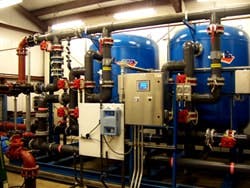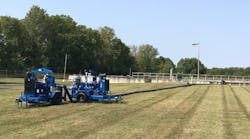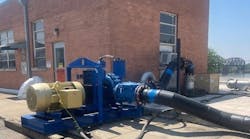Background
In late 2009, Water Works Engineers contacted AdEdge Technologies to design and implement an arsenic, iron and manganese removal system to serve the city of Aurora, Ore. The existing water supply consisted of three wells feeding into a centralized distribution system with a maximum combined capacity of 500 gal per minute (gpm). The site had an arsenic level of 12 parts per billion (ppb), higher than the U.S. Environmental Protection Agency’s maximum contaminant level (MCL) of 10 ppb. The city of Aurora also had iron and manganese levels of 0.9 mg/L and 0.189 mg/L, higher than the secondary MCLs of 0.3 mg/L and 0.05 mg/L, respectively.
AdEdge worked closely with Water Works Engineers and Ashley Engineering to supply the treatment system, backwash recycle pump skid and components, chemical feed and instrumentation. AdEdge also furnished the system with a programmable logic controller (PLC) communications module to perform the automated functions needed for proper operation of the control valves. The system was constructed and commissioned in fall 2010.
The New System
The AdEdge treatment system featured a skid-mounted AD26 oxidation and filtration package unit sized for a maximum design flow rate of 500 gpm. The model AD26-7260CS-3-AVH utilizes AdEdge ADGS+ media in a three-vessel carbon steel configuration in series. ADGS+ is a manganese-dioxide-coated silica media that is NSF 61 certified and used in the removal of iron, manganese and arsenic. Chloring is injected ahead of the treatment unit through a chemical feed to oxidize As (III) to As (V) for optimized performance. The system is equipped with automated control valves and harness, a central control panel with PLC and a color user interface screen.
System features also include differential pressure switches, flow sensors and totalizers and sample ports for a complete functioning packaged unit. Each 72-in. diameter treatment vessel contains approximately 84 cu ft of AdEdge ADGS+ oxidation filtration media. Using the AdEdge H 2 Zero Backwash/Recycle system, backwashing occurs every three to four days based on the incoming levels of iron and manganese, and is programmed using the PLC. Water exiting the treatment system feeds the 300,000-gal storage tank and is distributed to the end users.
Positive Results
The system began operation in November 2010. Since the installation of the system, the arsenic, iron and manganese levels are below the treatment goals of 10 ppb, 0.3 mg/L and 0.05 mg/L, respectively.


